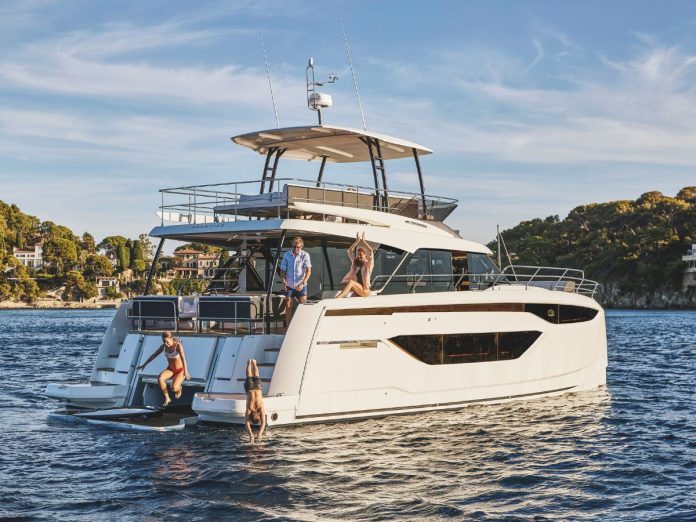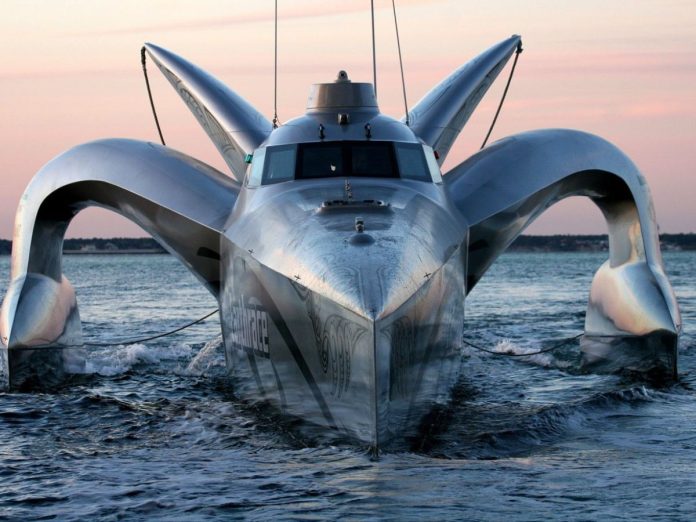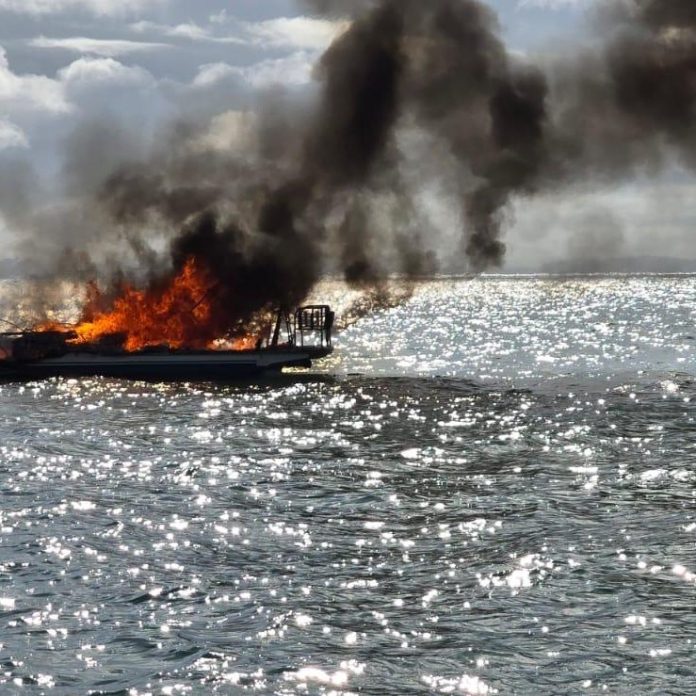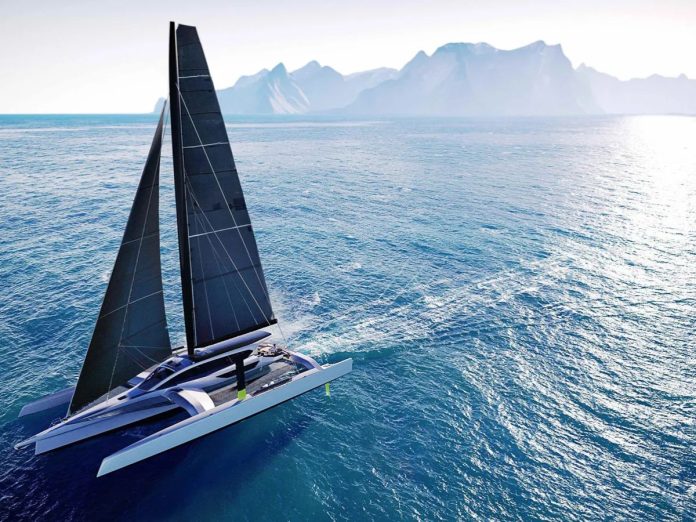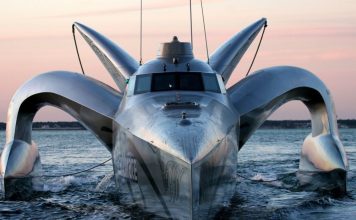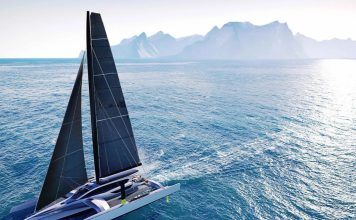Showing your hand too early in poker, or indeed in any emerging market, is a gamble, so the Beneteau Group wisely took their time in releasing a new power cat range. Of course, the odds were highly stacked in their favour, given the vast experience across this group of companies. And another wise play was choosing the Prestige subsidiary and its well-credentialled Garroni family to do the design.
The result was before me at the Sanctuary Cove Boat Show 2025, the stylish M48 power catamaran – the first in a new range that includes larger sister, 65-foot M8, and the recent M7 (17.84m) announced at the 2024 Cannes Boat Show. Francophiles might consider taking up Australian dealer TMG’s offer of taking delivery on the Med.

As to where this new range will fit into the already crowded global power catamaran market, a major clue comes from Beneteau’s June 2024 reorganisation. It’s now split into three major divisions: Sailing (monohulls and multihulls), Dayboating (motorboats from 20 to 40 feet for day cruising) and Real Estate on the Water (motoryachts from 40 to 80 feet).
The Prestige M range fits into the latter, so apartment living is the standard and high comfort levels are aimed for. Stepping aboard this first M48 at Sanctuary Cove confirmed this approach to me and demarked the model range with some clear market differentiators: an extremely high standard of finish with the emphasis heavily on life at anchor or at slow motion, given its modest performance. However, this doesn’t preclude a hull sturdy enough to cope with the big swells of Sydney, as I experienced during our sea trial.

Walking down the pontoon from Aussie dealer TMG’s office at The Spit in Sydney, the side profile of the M48 confirmed again to me the stylish aesthetics typical of the Prestige powerboats I’ve sea-trialled over the years. Raked lines, cleverly disguising ample volume. That was only the side profile; a closer look revealed a fairly narrow vessel, by catamaran standards, so it will fit into a berth suitable for a 60-foot monohull.
Some unusual design features, such as the transom garage-cum-locker, prompted me to check the bridgedeck clearance (estimated to be about 0.8m), which is adequate. Stepping aboard via the wide hydraulic swim platform sets the tone of what is clearly a luxury power catamaran, with a covered stern cockpit and semi-open flybridge. The swim platform elevates to nearly deck level and is rated at 250kg and so can take a 3.6m Highfield tender with a 20hp outboard.
Inside the large garage, our review boat had an 11kW generator with water tanks forward, plus storage; its door relies on good seals because it’s just above sea level. There’s also access to it from the cockpit sole.
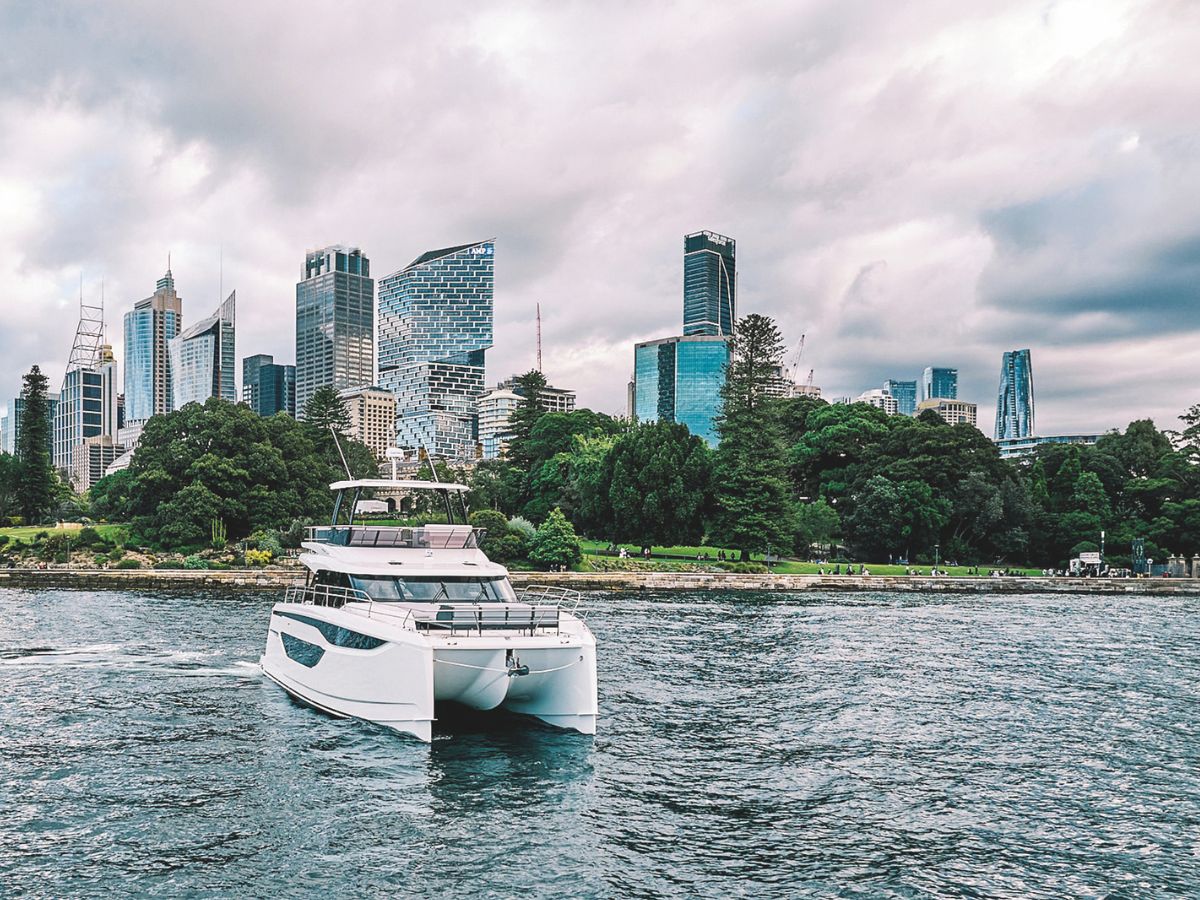
The large cockpit has teak underfoot and a good wet bar and fridge. It can accommodate perhaps 12 around the table, seated on the transom couch and adjoining small seats. It’s a versatile space because, instead of mouldings, stainless tie-rods fix the Roda furniture, allowing the central transom to open, creating a balcony or terrace when the swim platform is elevated.
Hatches in the sole on both sides of the cockpit provide engine access and the cockpit’s port side even has a gunwale door.
Spacious flybridge
Climbing up the wide teak stairs to the flybridge reveals a third level of living space, along with the main helm. Here, the same flexible and semi-customisable approach is used as in the main cockpit, with a rod-mounted U-shaped couch, movable backrests, and a dining table. The fibreglass top provides shade while still allowing good airflow and sunbathing at the back.

Forward is the wet bar, and to port is the main helm station – ideal flexibility because the downstairs helm is on starboard.
The helm station’s adjustable, outboard wheel makes berthing easy, and the views are superb – especially useful for those tropical, coral-strewn parts of the world. Engine controls include a joystick that integrates a bow thruster with the Volvo 320hp shaft-drives. Navigation is via twin 16-inch Garmin multifunction displays and the Volvo digital display. A separate paddle control for the bow thruster is handy, given the windage of this style of boat.

In addition, a third station can be fitted downstairs to port, but our boat came with a wireless Dockmate joystick controller that skipper Joe Fox ably used during our marina departure.
Smart designOur review boat was hull number 15 of the M48 range. The M48’s naval architects included some of the biggest names in French design, with Phillip Briand and Marc Lombard cited, but the laws of physics are even more famous. Elements such as power-to-weight, windage and drag. Taking the first, the modest 320hp engines require an efficient hull form to reduce drag. And, as a non-planing vessel, the M48 comes with sufficiently wide hull forms to cope with load while avoiding excess drag. In addition, as mentioned, there is enough bridgedeck clearance to further reduce wave slap. The build is infused GRP laminate, which minimises the M48’s weight (17.5 tons). The build is done in Jeanneau’s vast Les Herbiers plant, while the M7 and M8 are built in their Italian yard on the Adriatic Sea, one of my favourite cruising grounds. Hull shape comprises tall topsides with reverse bows, which also have spray flanges. Propulsion on the M48 is via V-drive shafts that connect to the Volvo 320hp D4 engines. These turbocharged, four-cylinder, 3.7-litre, common-rail power plants are ideal workhorses for this type of displacement vessel. Accessing them is via a false floor in each hull, which slightly impairs servicing but is still accessible. Above these floors, most of the electrical systems are located, safely away from water incursion. Stored power is a bank of three AGMs (400Ah) controlled by a digital management system located in the saloon. |
Wide side decks
Deck space is generous, with wide side decks and tall guardrails that guided me forward to the foredeck. The unconventional bow layout can offer a vast amount of lounging space, with optional seating across the bows under a sun awning, in addition to the conventional sunpads used on our review boat. Not an advisable option for anyone going offshore, but ideal for boating Sydney Harbour, the Gold Coast Broadwater or the Waitematā.
Practicalities are not forgotten, with a smallish Lewmar windlass and deep anchor locker allowing easy anchor deployment. Large lockers on either side under flush hatches are big enough to house a crew (an option), with a head on the opposite side, and can be air-conditioned.
Saloon
Entering the saloon, I found the walnut veneers with matching rattan carpeting and stylish fretwork panels throughout projected a sense of calm. The colours chosen could have made the space feel a bit gloomy, but instead the tall surrounding windows enliven the entire space with natural light.
The layout has an enclosed galley at the back with elevated dinette in the middle and a compact helm station to starboard. Vertical bulkheads maximise space, with skylights and large front windows for navigation.

The enclosed aft galley has a narrow entrance, so it’s secure at sea, but a bit constricted for two people preparing food. However, its rear opening window is ideal for serving the cockpit. Cooking is courtesy of an induction cooktop and convection microwave oven. There’s a deep sink, a small dishwasher under the bench and a washer dryer is also secreted in the nacelle starboard side.
There’s a household-style fridge with freezer and underfloor storage to keep the red wine ambient; the glasses are stored safely in recesses among the cupboards opposite. This cupboard also houses the digital electrical management system, which includes the main battery switches.
In the lounge, sumptuous Roda cushioning encloses the marble dinette table, which should seat eight around the U-shaped couch. The stylish marble-like finish is actually composite – the same material used for the worktop in the galley. Opposite is the bulkhead with an elevating television, near a small but functional side deck door. This is just behind the single helm seat. This helm has most of the same equipment as is installed in the flybridge, apart from smaller 12-inch screens, making it the ideal place to navigate from when offshore.

Owner’s suite
The M48 is intended as an owner’s boat, so it has three large cabins, but a four-cabin version is available, all of them roomy because of a major feature that few competitors have. This is the near-deck-level master suite.
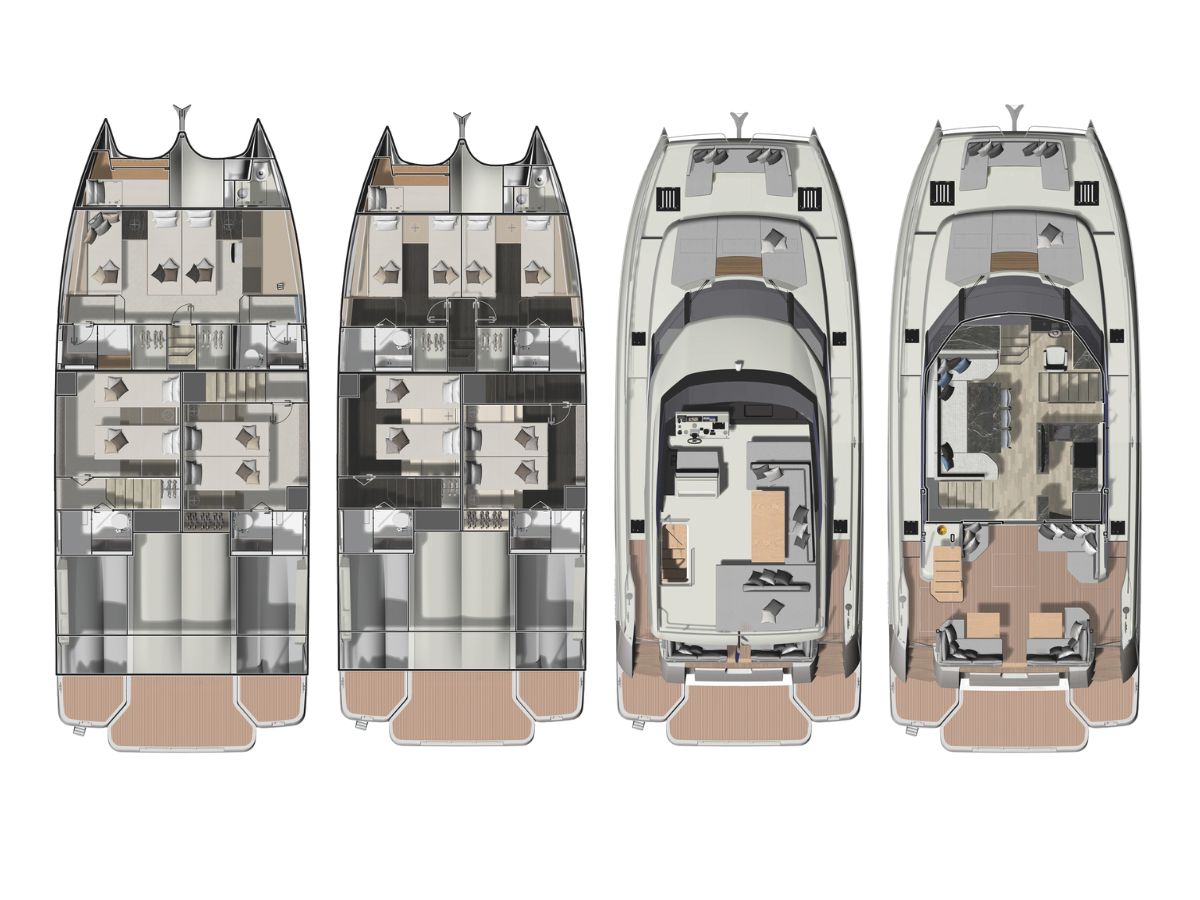
The master cabin is the outstanding feature on the M48 because it uses the full 20-foot beam to create an extra-large room. Its positioning in the bow is not ideal during offshore passages, but at rest it’s the place to relax. Either on the king-sized bed or on the equally large settee, one of the largest I’ve seen in this category.

To starboard is a vanity with lots of drawers, so more of a desk. Storage is also good, with underfoot lockers and large wardrobes. Ablutions are separated across the space, with the spacious shower stall port side and the toilet on starboard, ensuring privacy for both. Natural light is plentiful, including from forward-facing windows and large skylights, which are also good for natural airflow.
Again, the stylish Garroni finish is apparent with darkwood fretwork patterns on the headboards and accompanying bulkhead finishes.
The two double cabins are the same, one in each hull with dedicated entrances, and handily, their athwartship beds split to become singles. They offer great versatility with style, including the Corian-clad bathroom. Spacious with a shower and toilet, its location aft insulates the accommodation from engine noise. As a guest, my pick would be the starboard cabin with ensuite, as the port cabin has a corridor between it and the bathroom, which is the day head.
Motoring on Sydney Harbour
A bumpy Sydney Harbour proved a good testing ground for the M48, with just enough swell to send the spray over the decks. Sat high up at the flybridge helm, I remained dry, if slightly windswept.
The electronic steering wheel and matching throttles did my bidding quietly, allowing me to focus on the oncoming ferries, the yachts demanding their right of way, and the hardy canoeist braving the 18-knot westerly.
Setting off in long-range cruise mode – at eight knots – is ideal territory for the M48, giving a decent range of about 500 miles. Moving up to a fast cruising speed (15 knots), while at a 30-degree angle to the metre-high swells off Sydney Heads produced little complaint from the M48.
No groans, crashes, or indeed any structural sounds, which I found impressive. Still, this is what the M48 is designed for, so it’s clearly fit for purpose.
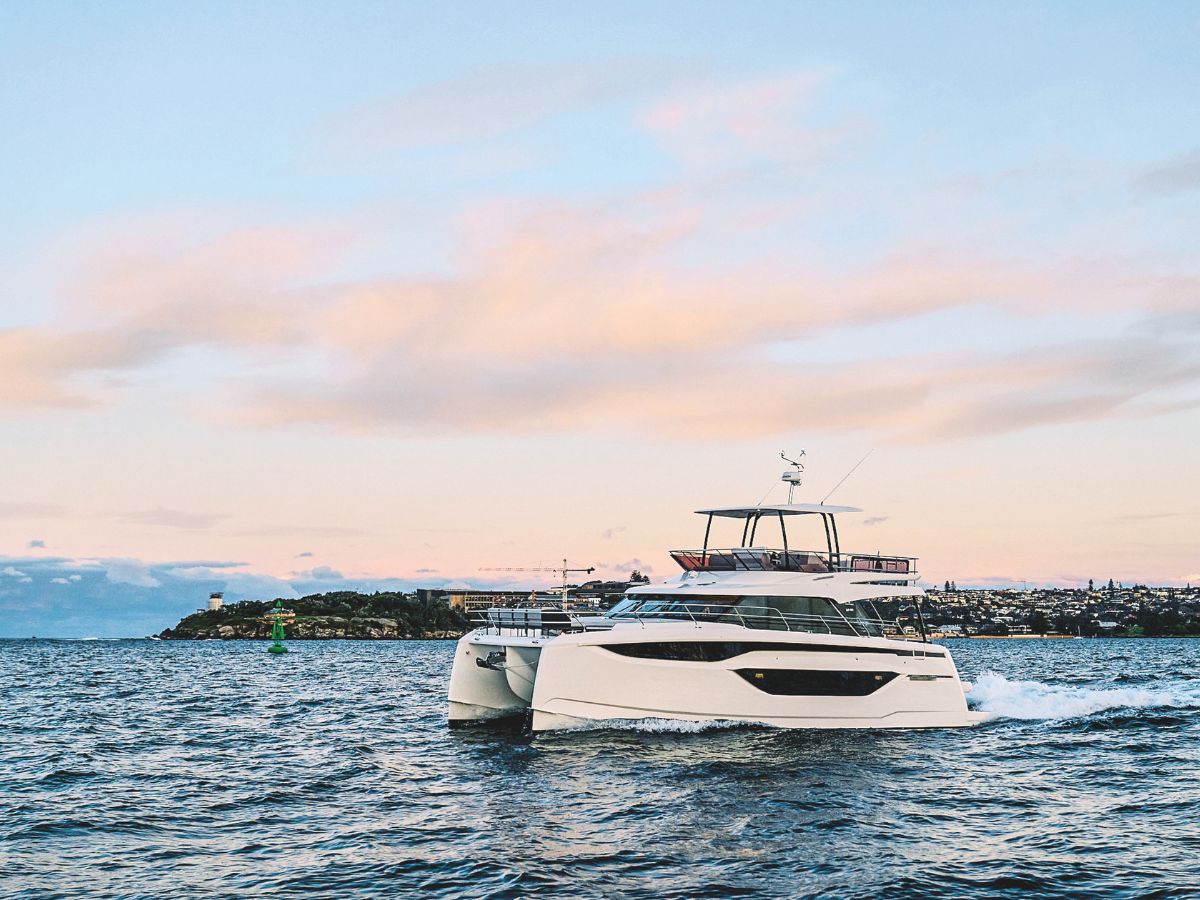
Stepping below decks, I used the inside helm for our top-speed trials, noting no change in trim at speed, so my view wasn’t obscured. With the throttle fully down, our maximum speed of 20 knots means there is more than enough speed to outrun a bad squall if needed.
Also, the sound levels seemed much quieter than the 70dBA we recorded, as the cab seemed fairly hushed. Returning to Middle Harbour with a following sea, I played the throttles to give an enjoyable downhill ride before doing some slow manoeuvring.
Despite a strong side wind and the vessel’s tall topsides, the Volvo joystick controls allowed me to motor straight astern (using the single bow thruster with the shaft-drive engines).
So, my experience with the M48 confirms my original hunch: I’d say the odds are very favourable for the Prestige M48’s success in this burgeoning power catamaran market.
BNZ
Highlights
Prestige M48
LOA 14.79m
Beam 6.00m
Draft 1.08m
Bridgedeck clearance 0.8m (estimated during sea trial)
Displacement 17.5 tonnes
Fuel capacity 2 x 600 litres
Water capacity 600 litres
Test engine Twin 320hp Volvo Penta D4s on V-drive shafts
CE Category B for 12 people
Cruising speed 8-15 knots max speed 20 knots

Specifications
Efficient hull design, relatively light weight Cruises comfortably at up to 15 knots Stylish Garroni interior details
Learn more
www.tmgyachts.com
www.orakeimarine.co.nz








